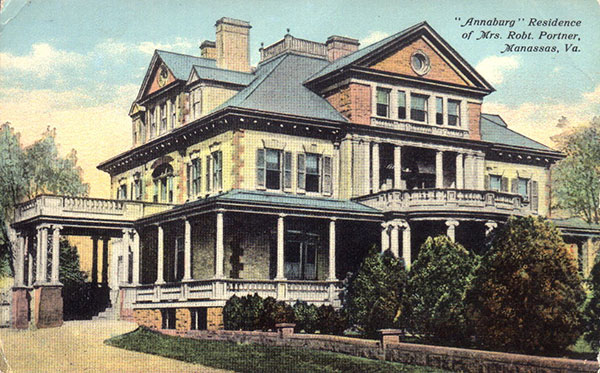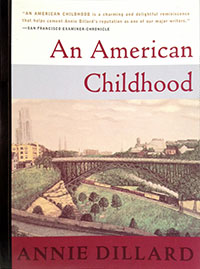In 1961, when I was nine, I fell under the spell of a crumbling stone tower. It stood on the weed-choked property of the Portner Manor in Manassas, Virginia, catty-corner from my cousin’s house. As a devotee of Trixie Belden books, I craved mysteries the way other kids longed for ponies. Here was a mystery within spitting distance!

My cousin and I talked about the “Civil War look-out” tower until we finally had to climb it. Fighting briars, we thrashed our way to its base. Ivy cloaked the three-story red sandstone structure topped with gap-toothed battlements. Up close we noticed portholes and arrow slits. Some of the spiral steps outside the tower had caved in. We straddled the gaping hole, half-expecting a bony hand to grab our ankles, and crawled to the top.
The two upper floors had collapsed, but the round walls were intact, covered with creamy wallpaper and faded squares where pictures had once hung. We crept back down the steps and peered into the hole, certain a tunnel connected the tower to the estate gatehouse. Then we flailed through the brambles as if chased by Portner’s ghost. Back at my cousin’s, we threw ourselves on the ground, sweaty and victorious.
The “Civil War” tower really dated to 1882 when the mansion was built. But even if we’d known that fact as kids, we wouldn’t have cared. Manassas was steeped in history, but we traipsed through the decades, mixing rockets and cannons with gossip and make-believe in our daily play. We heard our grandfather, who’d been an undertaker long before we were born, say cryptically that during the Depression “people were too poor to die,” and wondered what happened to those people. Everything was a mystery.
 In An American Childhood, Annie Dillard wrote, “We children lived and breathed our [city’s] history … We knew bits of this story, and we knew none of it.” My cousins and I knew bits of our town’s story and yet none of it. Geography was a tool to suit our purposes. We raced around the nearby battlefield, dodging monuments, our games shaped more by our imaginations than what had actually happened there.
In An American Childhood, Annie Dillard wrote, “We children lived and breathed our [city’s] history … We knew bits of this story, and we knew none of it.” My cousins and I knew bits of our town’s story and yet none of it. Geography was a tool to suit our purposes. We raced around the nearby battlefield, dodging monuments, our games shaped more by our imaginations than what had actually happened there.
In the field between the lumber yard and my cousin’s house, we turned over stones, hoping to find arrowheads or cement-colored minieˊ balls. We chased milkweed fairies to make modest wishes and, once, marveled at a clutch of speckled killdeer eggs resting in a pebble nest. Our sneakers pressed into the past, kicked up the red dust of the present, and pointed toward the future. We walked, as Dillard said, “oblivious through littered layers” of history, trespassing, running across other people’s yards. We owned that town.
Now I live in Fredericksburg, Virginia, a town even richer in history. I step across the same cobblestones where Washington and Jefferson once walked. Five major battles ripped through here during the Civil War. I wouldn’t expect kids today to wonder about Jefferson or Chancellorsville as they drive down Route 3. But I don’t see their sneakers touch the ground much, either, except during soccer and softball games.
Where are their mysteries? Do they weave Walmart and Dollar General into their free play? Movies and TV bombard kids with enough toys, costumes, and spin-offs to fuel “imaginative” play into the next millennium. Why would they scrounge for arrowheads when they have the latest Happy Meal toy to keep them entertained for five seconds? Or the thrill of a flashy new app on their screens? What do they own?
“Know you what it is to be a child?” Frances Thompson wrote in 1909. “It is to turn pumpkins into coaches, and mice into horses, lowness into loftiness, and nothing into everything.”
Portner Manor was turned into a nursing home in the late 60s. After standing 86 years, the “look-out” tower was torn down in 1978. The nursing home moved to better facilities, and the mansion fell to neglect. It’s for sale now, possibly headed for the wrecking ball.
When I recall that twilight climb all these years later, I’m not sure if I really saw the creamy wallpaper, or made it up in heightened anticipation, or dreamed it. But I can still see dusty pink cabbage roses in my mind’s eye (though I question wallpapering the inside of a round stone tower).
Mostly I remember the smooth sandstone steps beneath my sneakers, the sun-warmed walls against my palms, the delicious floaty feeling in my stomach, and those lofty summers when we turned nothing into everything.

What a wonderful adventure to have as a child…and a wonderful memory to have as an adult. I hope that somehow today’s children are having adventures that feel as mysterious and exciting to them.